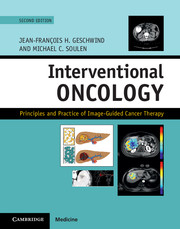Book contents
- Frontmatter
- Contents
- List of contributors
- Section I Principles of oncology
- Section II Principles of image-guided therapies
- Section III Organ-specific cancers – primary liver cancers
- Section IV Organ-specific cancers – liver metastases
- Section V Organ-specific cancers – extrahepatic biliary cancer
- 21 Extrahepatic biliary cancer: Stenting, brachytherapy, and photodynamic therapy
- Section VI Organ-specific cancers – renal cell carcinoma
- Section VII Organ-specific cancers – chest
- Section VIII Organ-specific cancers – musculoskeletal
- Section IX Organ-specific cancers – prostate
- Section X Specialized interventional techniques in cancer care
- Index
- References
21 - Extrahepatic biliary cancer: Stenting, brachytherapy, and photodynamic therapy
from Section V - Organ-specific cancers – extrahepatic biliary cancer
Published online by Cambridge University Press: 05 September 2016
- Frontmatter
- Contents
- List of contributors
- Section I Principles of oncology
- Section II Principles of image-guided therapies
- Section III Organ-specific cancers – primary liver cancers
- Section IV Organ-specific cancers – liver metastases
- Section V Organ-specific cancers – extrahepatic biliary cancer
- 21 Extrahepatic biliary cancer: Stenting, brachytherapy, and photodynamic therapy
- Section VI Organ-specific cancers – renal cell carcinoma
- Section VII Organ-specific cancers – chest
- Section VIII Organ-specific cancers – musculoskeletal
- Section IX Organ-specific cancers – prostate
- Section X Specialized interventional techniques in cancer care
- Index
- References
Summary
Obstruction or stenosis of the extrahepatic bile duct may be caused by primary tumor, tumors arising from surrounding organs (gallbladder, pancreas), or compression from lymph nodes. Bile duct obstruction is a frequent cause of morbidity and mortality among oncological patients. Failing liver functions due to obstruction in the bile ducts could preclude early surgical intervention, the application of chemotherapy agents which metabolize directly in the liver, and, in later stages, therapeutic intervention of any kind due to bleeding complications.
Extrahepatic obstructions may be differentiated as hilar or distal according to their locations anatomically. Tumors growing from the epithelium of the biliary tract are most common in the hilar region (65% of cases), and the complexity of the perihilar liver region causes curative surgical resection to be very complicated. Only a small percentage of such tumors are detected at an early stage. Tumors located in the hilar region often infiltrate or encase the branches of the common hepatic artery and portal vein, and cholangiocarcinomas expand longitudinally into the intra- and extrahepatic bile ducts, submucosally and perineurially. As a result, the actual radicality of the surgery may be debatable. Success in surgical resection is very low, and the 5-year survival rate is unsatisfactory even after curative resection due to a high percentage of local recurrence. The difficulty of resection rises in accordance with the level in the Bismuth–Corlette classification system. For type I, sometimes only localized resection of the common bile duct with biliodigestive anastomosis is possible. For types II–IV, liver resection is usually necessary. Extended left or right hemihepatectomy often requires presurgical embolization of the portal vein. Radical procedures include extensive lymphadenectomy, which is made difficult by the structure of the hepatoduodenal ligament with respect to the adjoining branches from the portal vein and the adhesion of afflicted lymph nodes on the biliary tract, portal vein, hepatic artery, or head of the pancreas.
Even though surgical techniques are continually improving, resectability of hilar cholangiocarcinomas is in the range of 15–20%, the 5-year survival rate is in the range of 10–30%, and local recurrence occurs in 75% of cases.
- Type
- Chapter
- Information
- Interventional OncologyPrinciples and Practice of Image-Guided Cancer Therapy, pp. 193 - 202Publisher: Cambridge University PressPrint publication year: 2016



